Hi everyone! It’s Kim Lapacek from Persimon Dreams with you today. In a blink of an eye, the school year comes to an end. All three of my girls had a fabulous teacher and literally cried because they didn’t want school to be over. My youngest graduated Kindergarten this year and it has been such a joy to watch her excited as she learned so much. I make a little gift for each teacher but for the Kindergarten teachers, I like to do something a little extra and little more full of memories. Join me today as I share how to create this unique Hand Print Owl Quilt using HeatnBond® Lite Fusible Adhesive.
PS – this is not only a great gift for a teacher but also anyone who is special to a group of children!
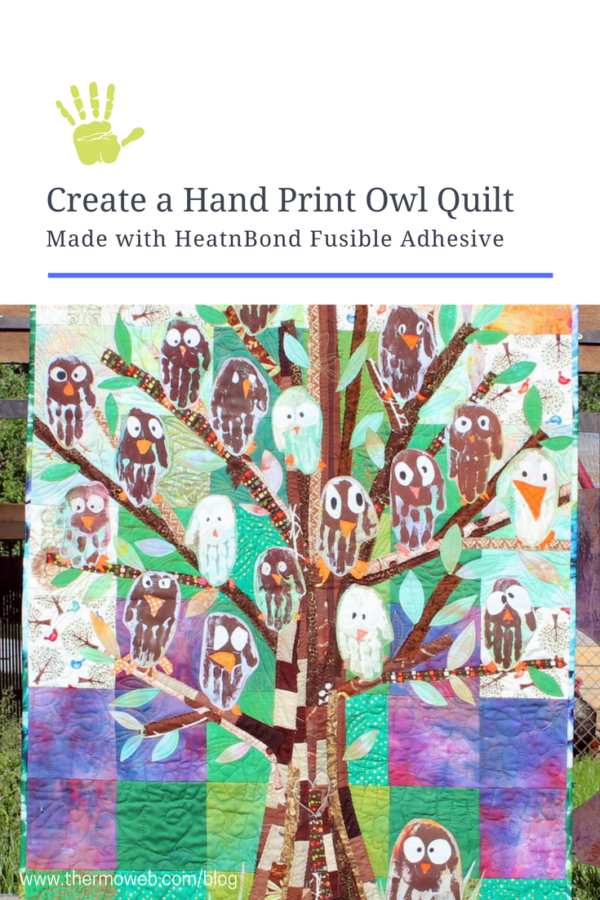
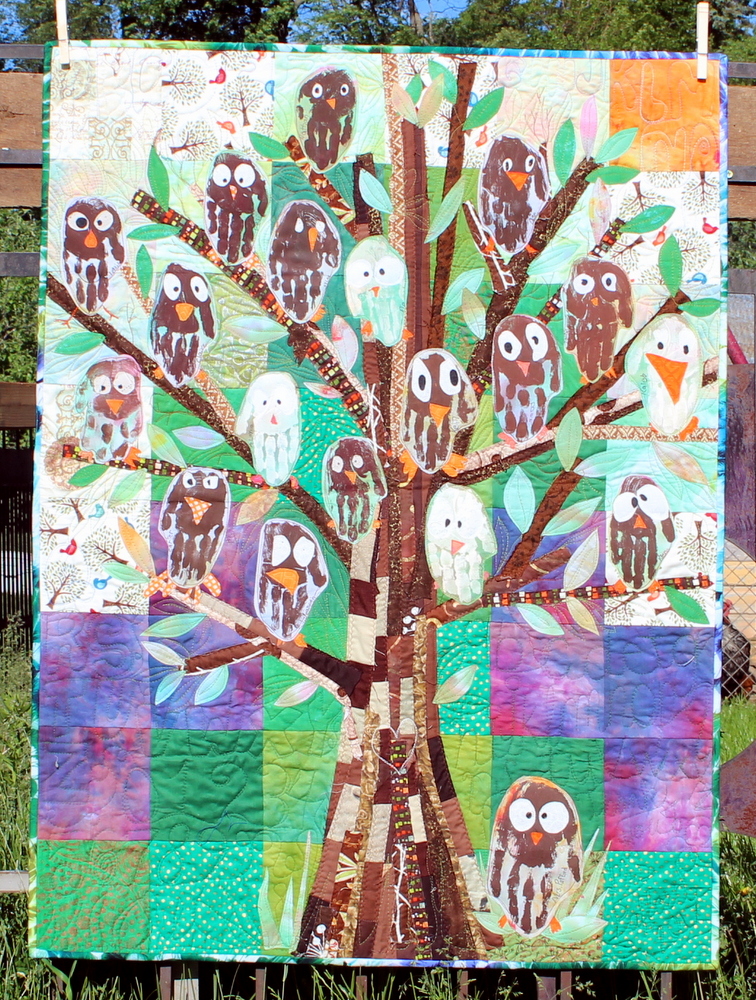 Create a Unique Hand Print Owl Quilt Using HeatnBond
Create a Unique Hand Print Owl Quilt Using HeatnBond
Hand Print Owl Quilt Supplies:
Acrylic Paint (or Fabric paint but acrylic paint is less expensive and works just fine) – assortment of browns, whites, and creams
Foam Brush
Paint Pallet
Pencils
Micron Pen
HeatNBond® Lite
HeatNBond® Heavy Weight
Pressing Paper
Aurifil Thread- 50 wt Aurifil 1104, 2021, 2892, 4012, 4655, 5016
Fabrics of your choice (this will vary from project to project)
-hand prints: measure the largest hand you will need a hand print from and make all of your fabrics that size. These were ~5″ x 7″ – a lot was extra but I used the fused scraps to make the leaves for the trees
– owl features – scraps of white, black, and orange fabrics
– background: an assortment of hand-dyed fabric and commercial prints to make a whimsical background. 48 – 5.5″ squares.
– tree: brown fabric scraps cut into strips
Hand Print Owl Quilt Instructions:
Step 1:
Find out how many kids you need hand prints from.
With that number in mind you can prepare the fabric for printing.
Choose fabrics that will contrast nicely with the color of paint you’ll be using for the hand prints. Fuse HeatNBond Lite onto the wrong sides of the fabric you are going to be printing on.
Determine the size of the largest hand and add at least an inch to each measurement. Make all of your pieces this size to minimize hassle.
I like to fuse to a larger piece of fabric first and then cut as many pieces to the size I need from there.
Step 2:
Create an owl template. On a sheet of paper I traced my daughter’s hand to create the template for the owl. I made enough copies for each of the children.
Step 3:
Pack up your supplies and bring it to the classroom.
I made a bag full of the fused fabrics for hand prints, owl templates, pencils, an assortment of acrylic paint, foam brushes and a pallet for the paint.
Step 4:
Collect the hand prints. With young children it is nice to have a helper for this step. Generously paint a single hand with acrylic paint. Instruct the child to put all their fingers (including their thumb!) tightly together. Guild their hand with yours to the fabric and press it evenly down on the fabric.
Write the child’s name onto the fusible paper to keep things straight.
Once the hand print it is on send them to the bathroom to wash up instructing them not to touch anything along the way!
Step 5:
Once their hands are clean, have them draw the eyes, nose, feet, and name onto the owl template.
Step 6:
Piece the background of the quilt.
Make a 6 x 8 grid of the 5.5″ squares you cut. By making the background this size you’ll be able to use a single yard of fabric for the back to eliminate the need for piecing a back.
Step 7:
Layer and baste the quilt. By doing this step now all of the stitching required for adding the tree and owls will become part of the quilting.
Step 8:
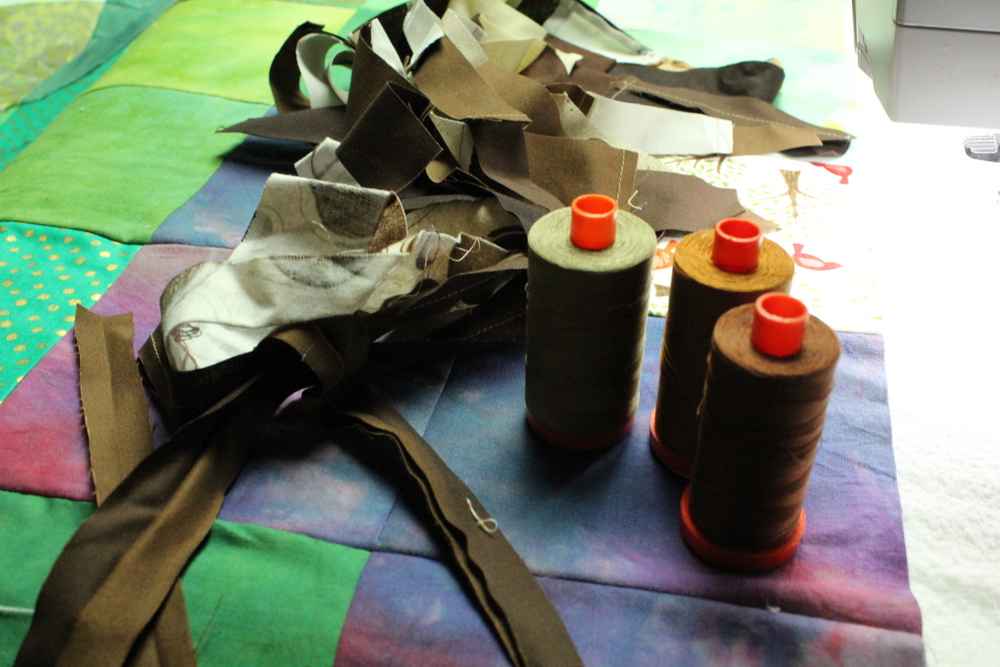
Take the scraps of brown and a selection of Aurifil thread. Pictured here is 50wt. in 2155, 2370, and 4012. I wasn’t quite sure which ones I would use but I like to be ready if I felt the need to change my thread. I ended up just using Aurifil 4012.
Stitch down the strips of brown fabric in what I call “free form raw edge piecing”. Literally lay a strip of brown fabric onto the quilt top and stitch it down. I recommend a zig zag stitch but a straight stitch or any fancy stitch is acceptable. It’s okay if a little puckering happens – your making a tree – they have lots of texture! Trees are really just lines – a nice thick line down the middle and some thinner lines splaying out at the top half of the thicker line. Have fun with this and remember that every tree is unique.
Keep adding strips of brown until the tree makes you happy.
Step 9
Transfer the owl features to the hand print. To really personalize this quilt, take the drawings the kids made of the eyes, nose and feet and transfer them to the hand print. This can be done easily using HeatNBond Lite and HeatNBond Heavy Weight. 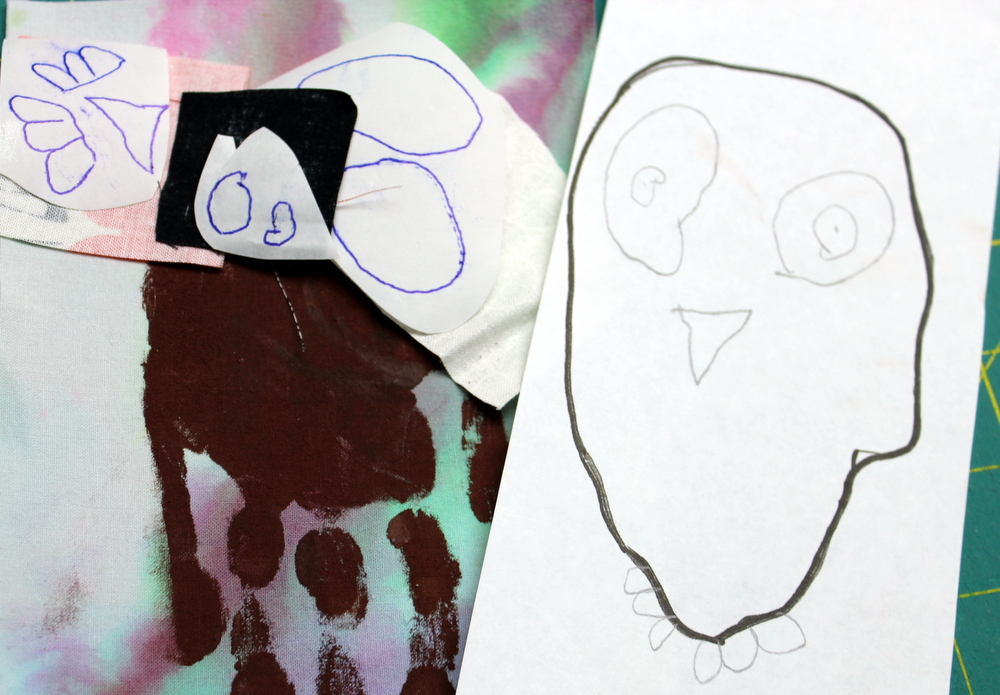 Lay the fusible sheets over the kids drawing and trace the shapes they drew. I recommend tracing anything you don’t want to have to stitch down to secure to HeatNBond Heavy Weight (ie pupils and any tiny features). Trace anything you don’t mind stitching down later to secure to HeatNBond Lite (ie whites of the eyes, nose, feet).
Lay the fusible sheets over the kids drawing and trace the shapes they drew. I recommend tracing anything you don’t want to have to stitch down to secure to HeatNBond Heavy Weight (ie pupils and any tiny features). Trace anything you don’t mind stitching down later to secure to HeatNBond Lite (ie whites of the eyes, nose, feet).
Trim the around the drawings generously and choose scraps of fabric for eyes, nose, and feet that you can fuse to. Press the fusible to the wrong side of the fabric and then trim along the lines drawn. Cut the hand print out of the fused fabric for the owl. Save the fused scraps to use later.
Peel the paper off the fusible on both of the hand print, the eyes, nose, and feet. Layout the pieces onto the hand print in a location as similar to the child’s drawing as possible.
Cover with HeatnBond Pressing Paper. Press for approximately 30 seconds with a hot iron. Just make sure nothing isn’t sticking.
I think these owl hand prints look so adorable!
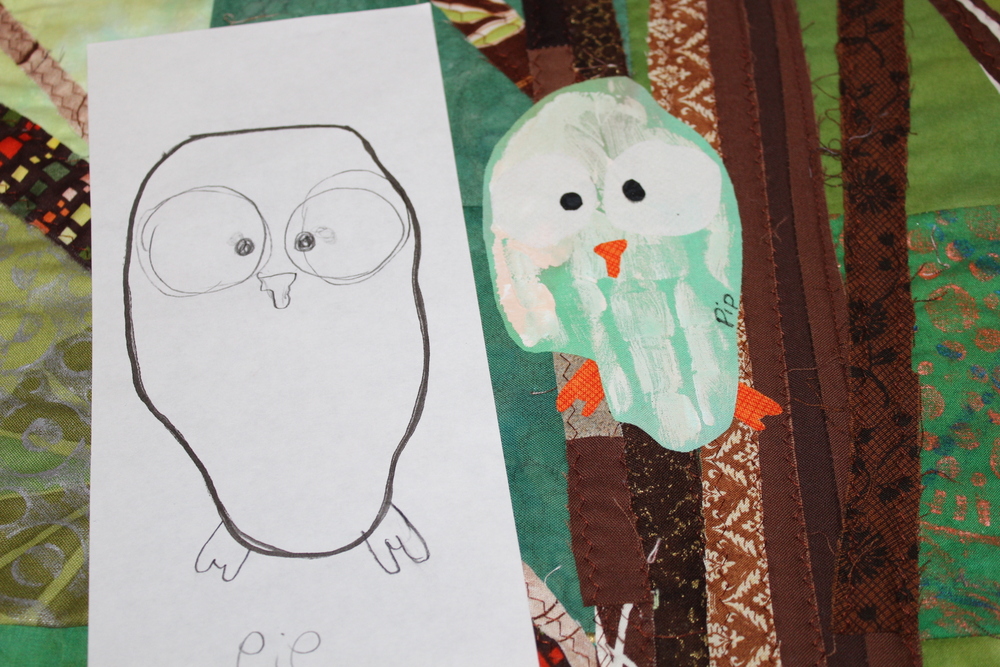
My daughter, Pip, was one of the kids that chose to make hers a snowy owl.
Repeat this until all of your owl hands are fused onto the tree. I decided to put the teacher’s hand on the ground by the base of the tree and all of her students in the tree.
Step 10
From the fused fabric bits left after cutting the handprints out, free form cut out some leaves for your tree. Then fuse those on – don’t forget to use the Pressing Paper – you don’t want your iron covered in paint!
Step 11
Secure all of the owl hands and anything else fused with HeatNBond Lite.
This is where you get to have fun with all of your Aurifil threads! Aurifil offers so many different colors that you can’t go wrong!
To stitch my owls down I used a little of the brown 4012 from earlier along with a white 2021 and orange 1104. I used 2892 for some of the leaf work.
Once everything was secure I still needed to quilt the background. For the sky area I used variegated Aurifil 4655. More leaf work and the “grass” was done with 40 wt. 5016.
If you look closely at the quilting – I quilted the alphabet (both upper and lower case) and numbers into the background. It seemed like the perfect theme for a Kindergarten teacher!
Step 12
Trim and bind in your preferred method.
Step 13
Give the gift to the teacher!
This was my favorite part! Finally giving the quilt to the teacher! The kids were all in awe of what happened to their hand prints they had made just a few weeks before.
This may be my favorite picture of the year – Pip with her teacher and the quilt.
~~~
If your teacher is not into owls – there are so many different themes you could go with.
The first hand print quilt I did was a “School of Fish” quilt.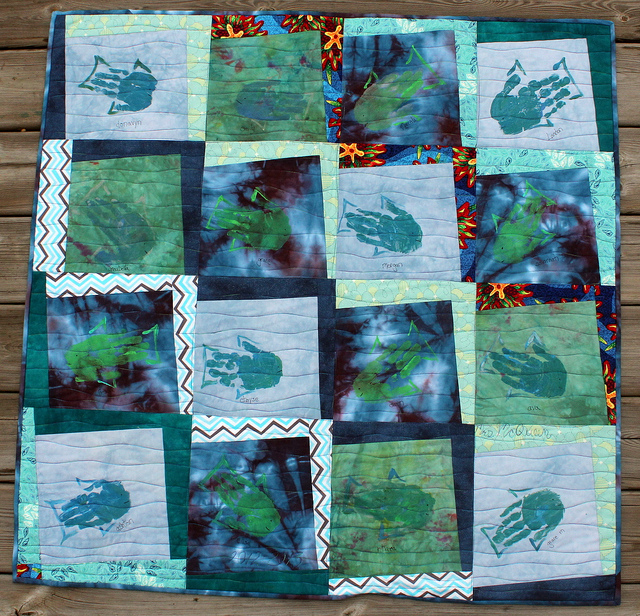
And the second hand print quilt was the “Very Hungry Caterpillar.”
The book “Calendar Kids: Handprint Quilts Through the Year” by Marcia Layton is a great source of inspiration!

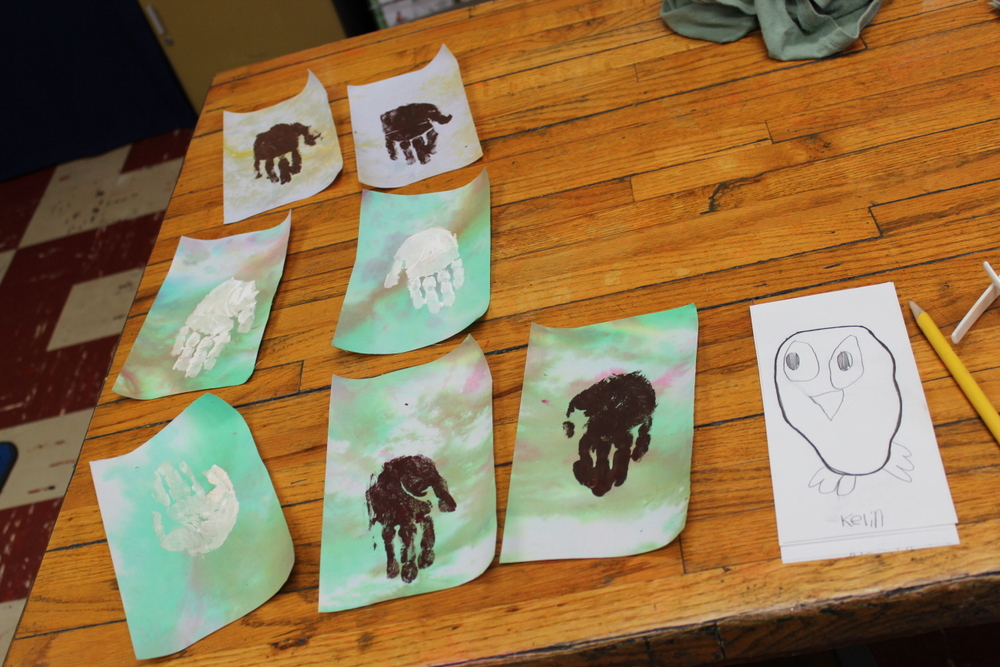

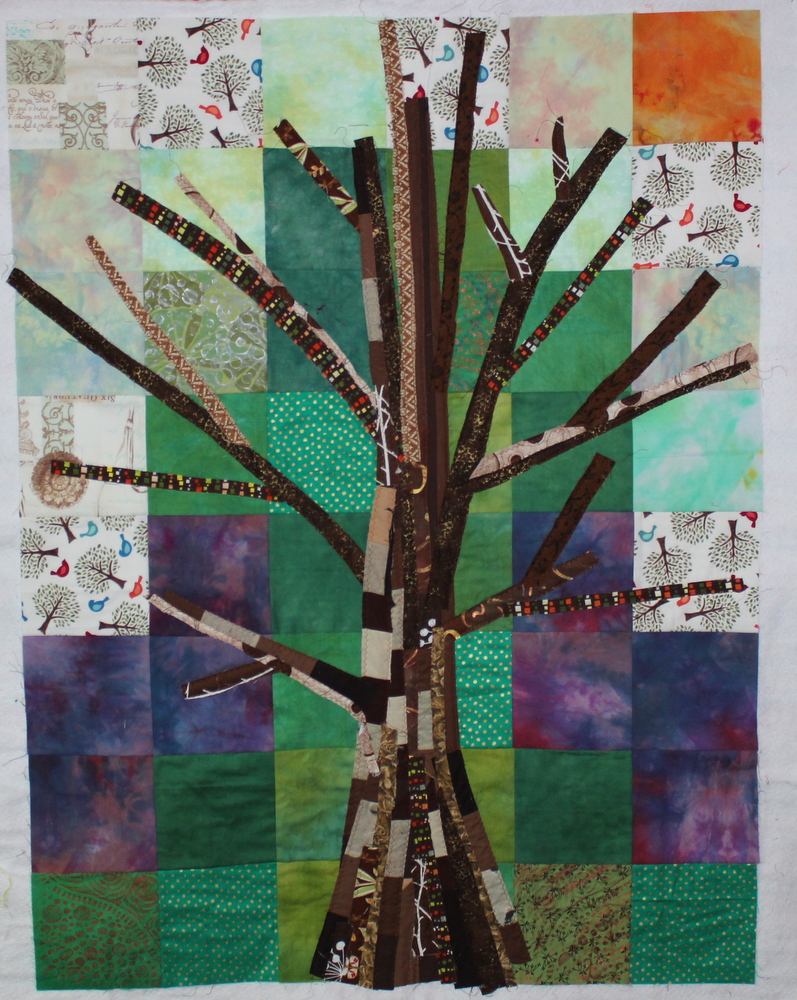
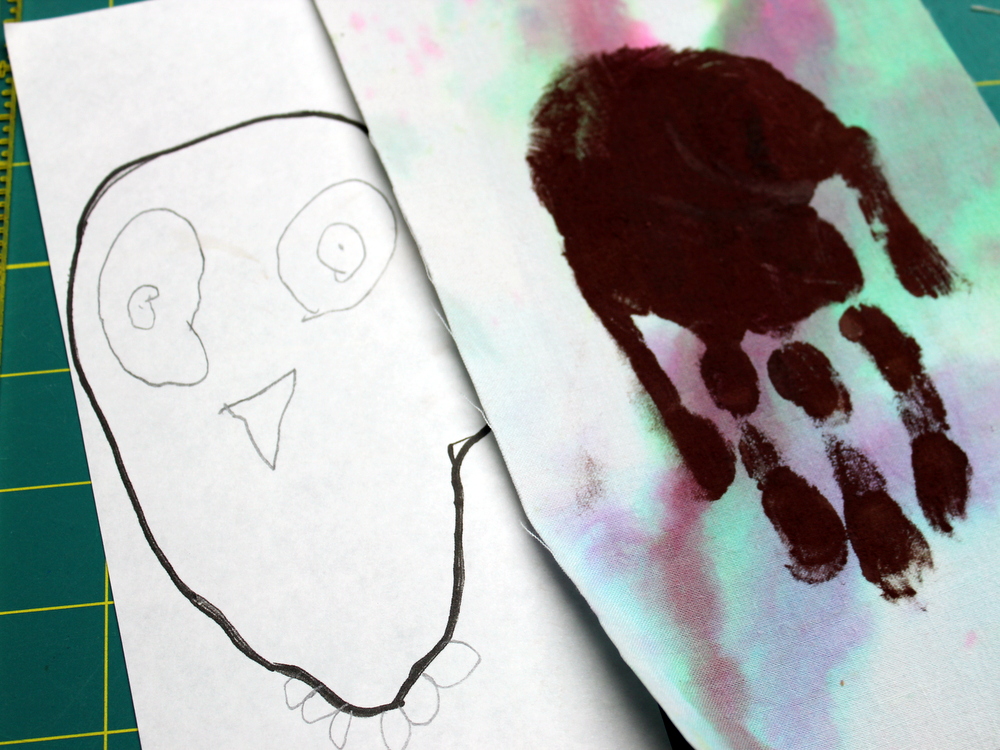
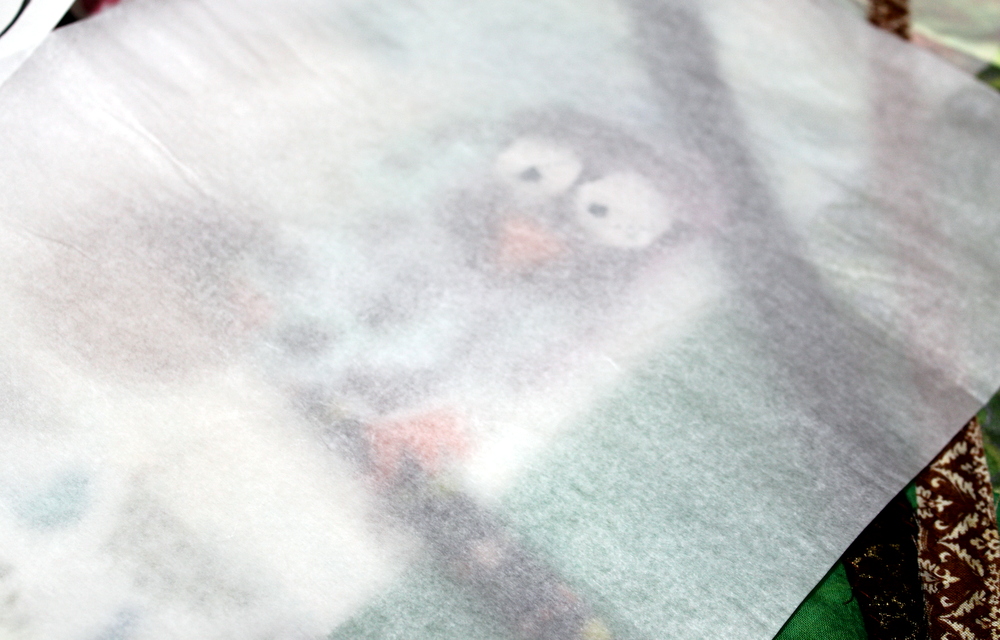

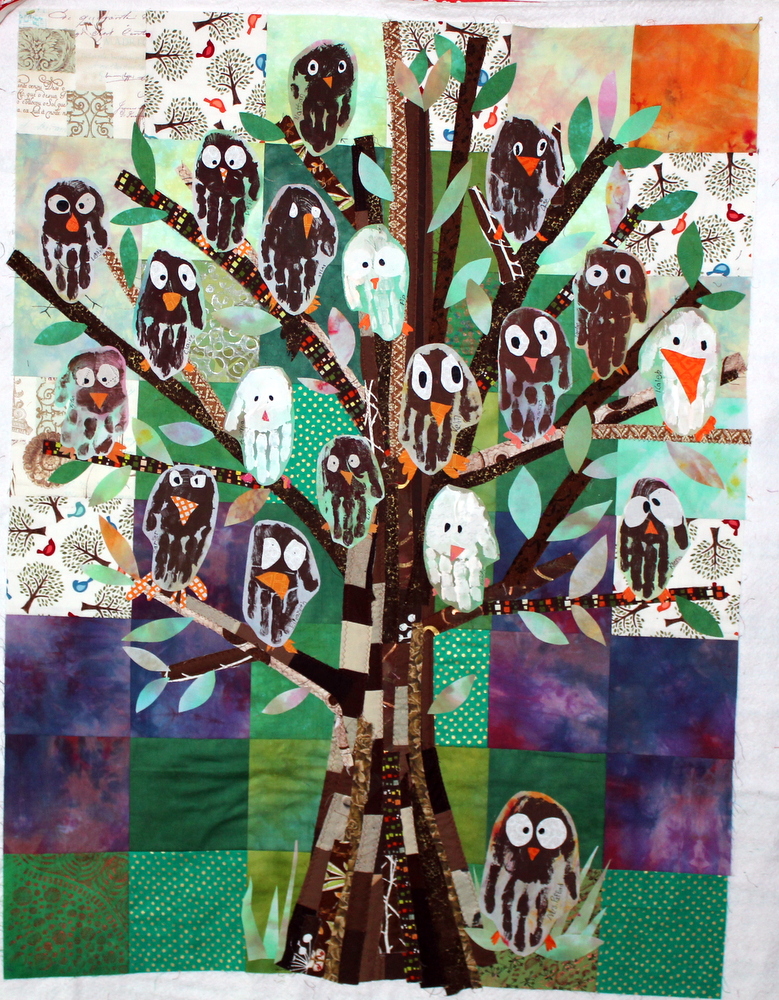
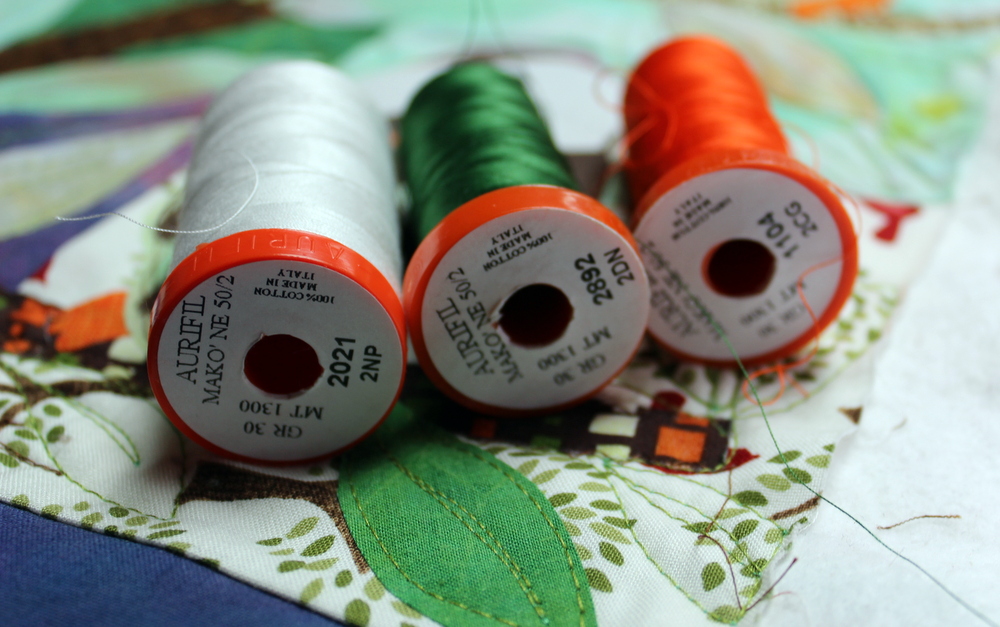
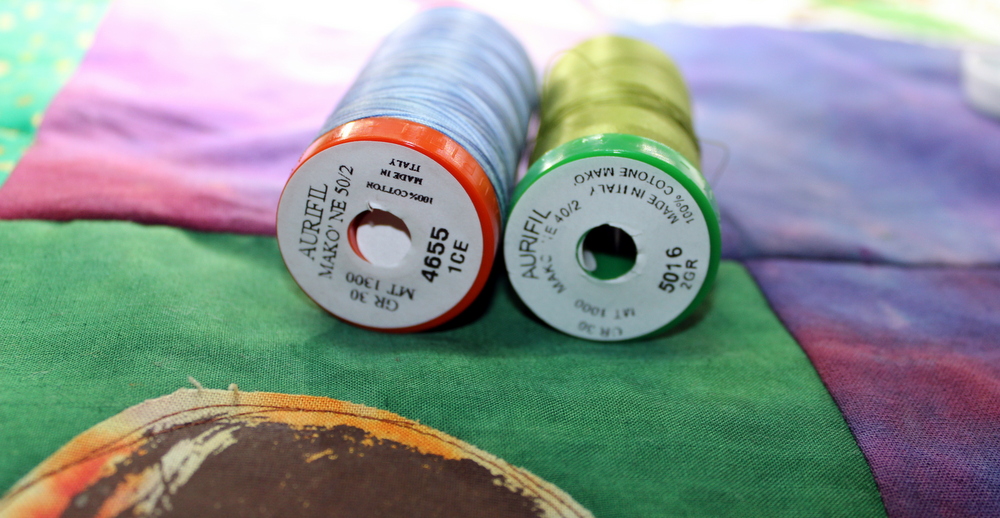
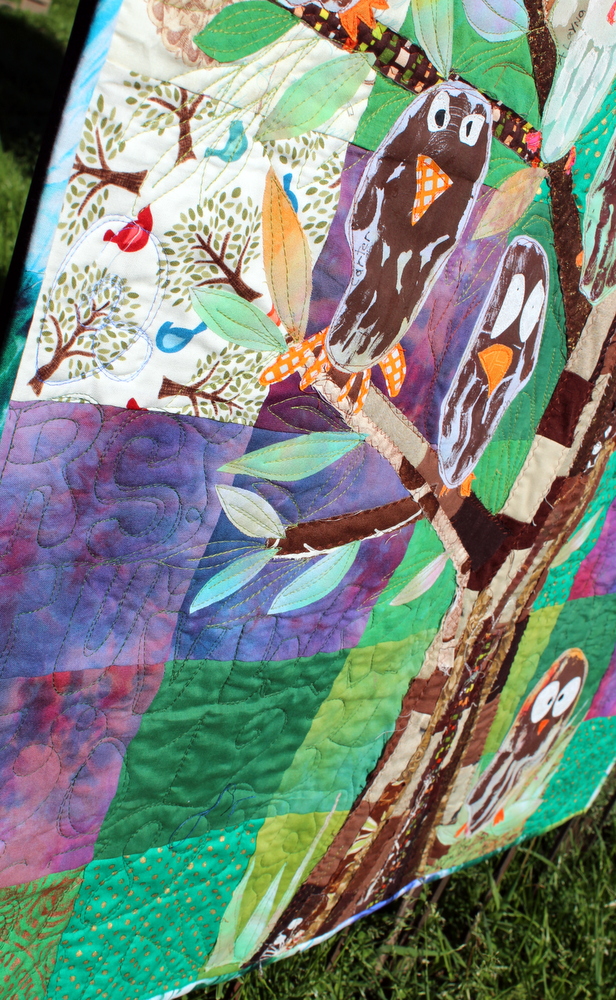
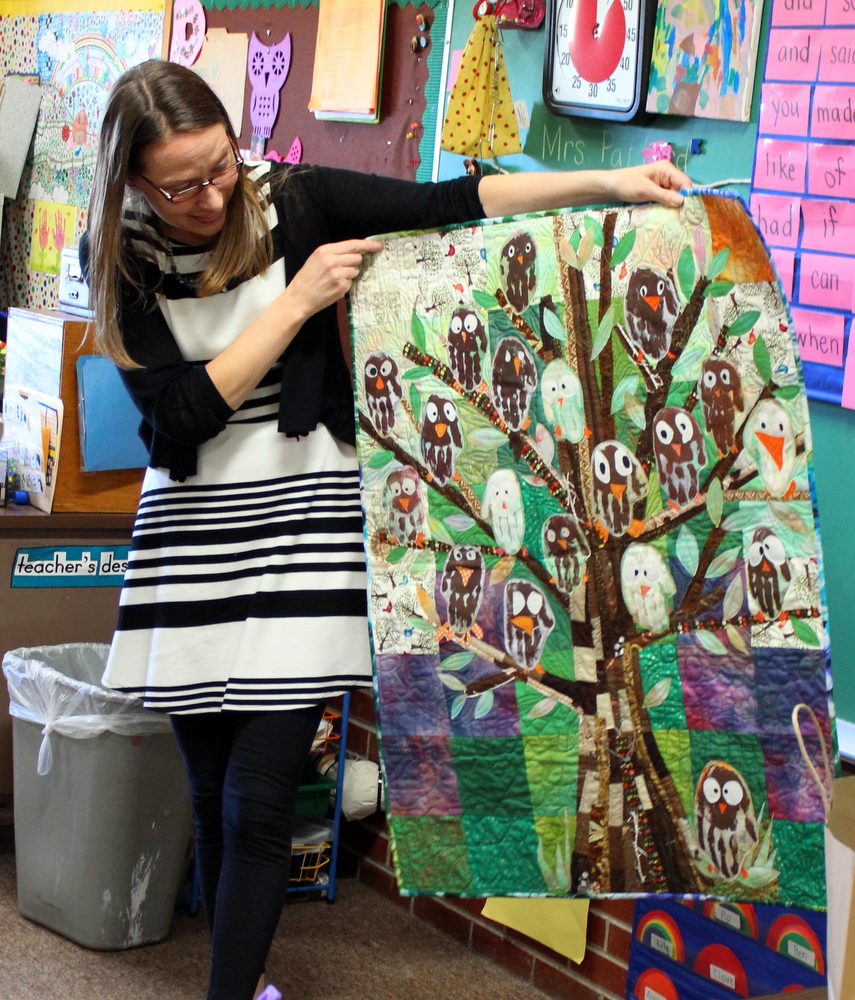
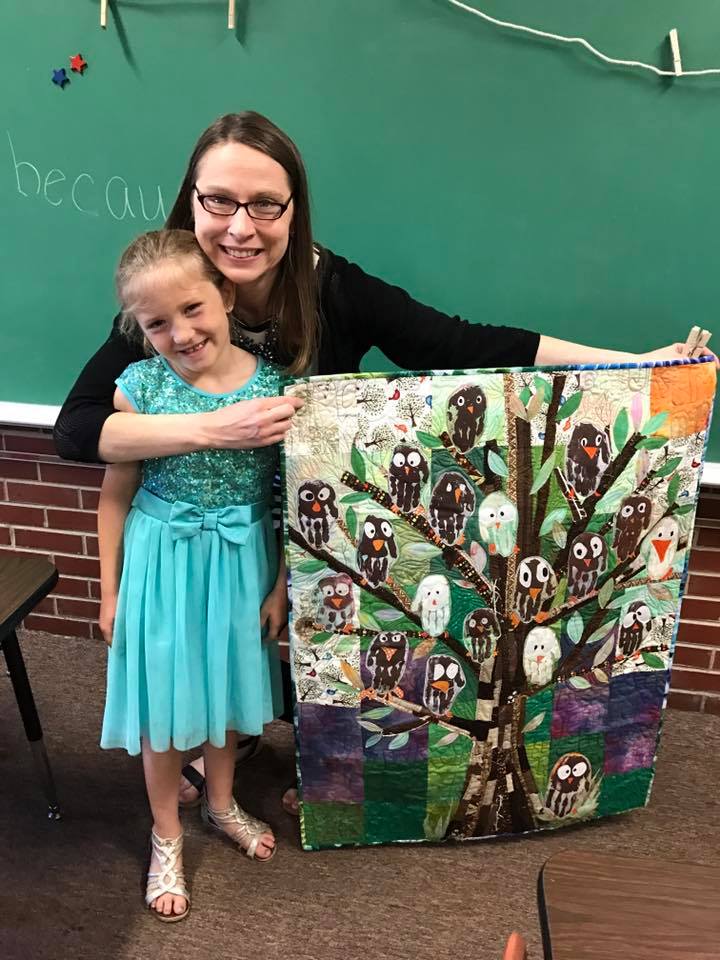
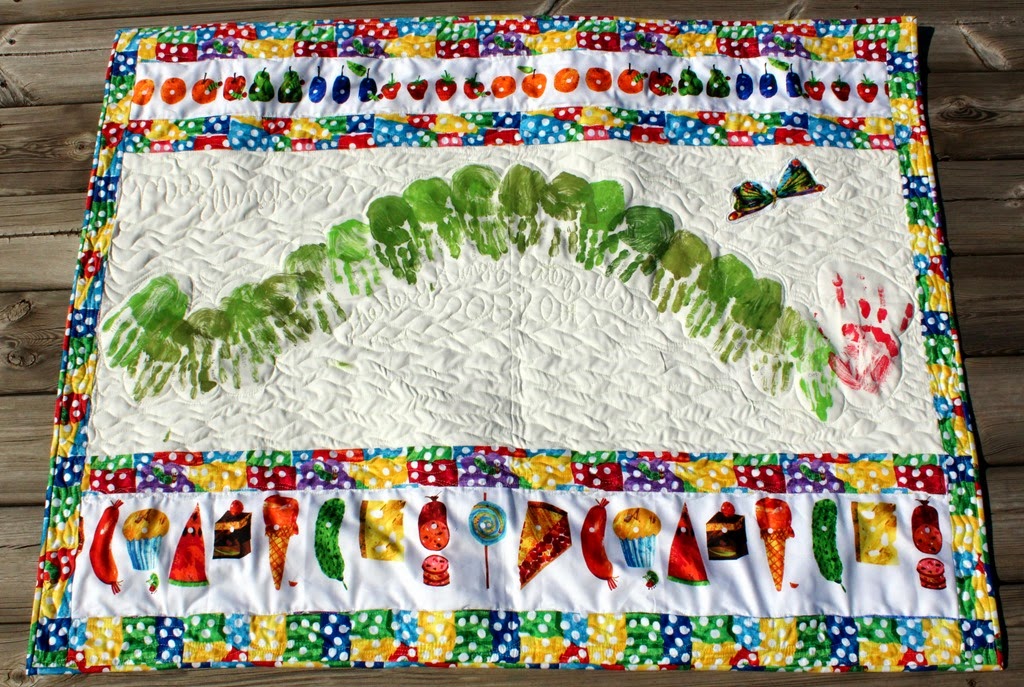
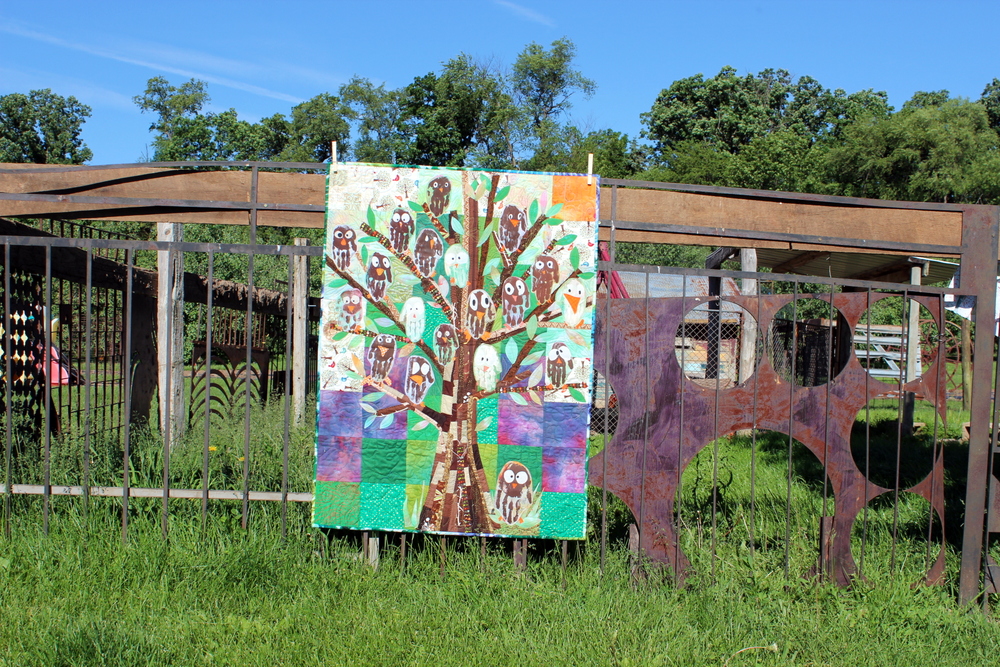
Kerry
June 13, 2017 at 11:36 am (8 years ago)Kim, you’re so talented, crafty and creative! I love this tutorial and can’t wait to continue experimenting in your footsteps. 🙂